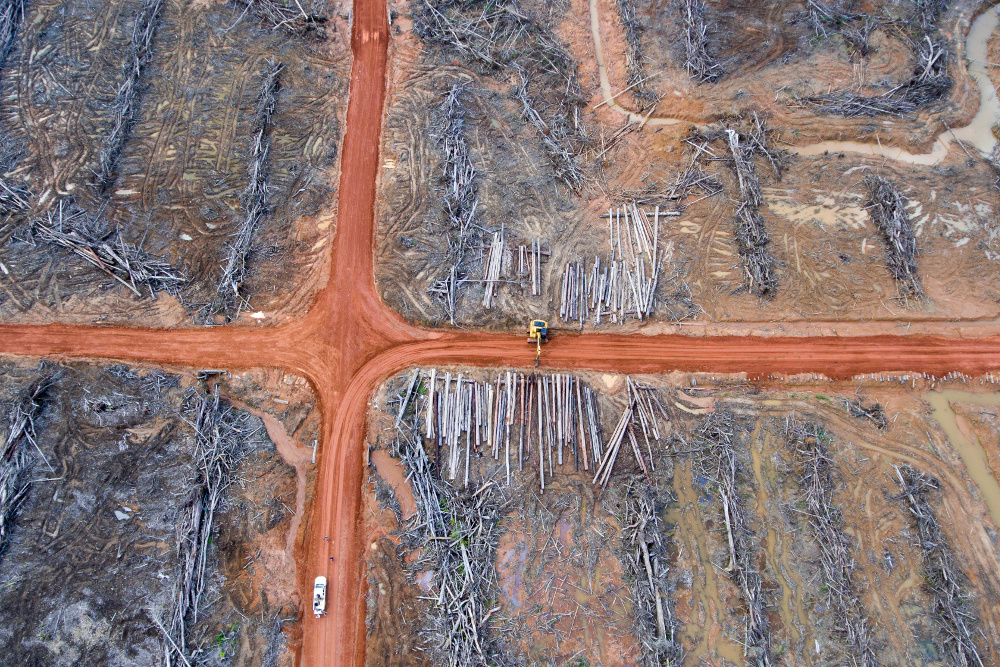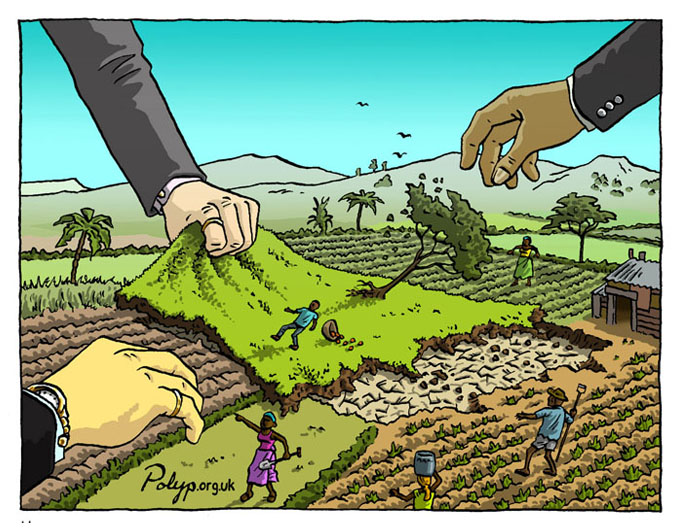by Jan Sändig, SFB 923, University of Tübingen
Land grabbing has been widely discussed in recent years. It seems quite evident why: Corporate investment in farmland has increased significantly and severely impacted many local communities. But this is only one reason why land grabbing has become a prominent topic. As I discuss in this article, it has also been “successfully” made visible by activists.

The issue of land grabbing rose to prominence during the food price crisis around 2008. At the time, many observers noted a massive rise of such land acquisitions. Foreign investors were estimated to have already acquired a tremendous 200 million hectares of land, possibly more. Suddenly, numerous “mega deals” of tens or hundreds of thousands of hectares became public. The case of Daewoo in Madagascar even suggested that entire countries were now up to sale. Such revelations drove the “hype” about land grabbing.
Today, about ten years later, the extent and consequences of large-scale land deals are better understood. It became obvious that the initial assessments were often exaggerated. Since the early 2000s, probably “only” about 42 million hectares of land were transferred from smallholders to agro-industrial corporations. Many announced land deals – especially the “mega” ones – have never materialized. For a variety of reasons, the rate of new land acquisitions has slowed in the meantime.
The topic still attracts considerable political and public attention, though. This is certainly due to the negative impacts of many land deals. When large plantations are created, local communities often lose land and income opportunities and face environmental degradation as well as repression. Millions of smallholders bear these consequences, although few community members may also benefit from jobs or lease payments. Nevertheless, I suggest that the prominence of land grabbing is not only due to the severity of its impacts.
To examine how political problems are brought to public attention, scholars often apply the framing perspective. It focuses on schemes of interpretation – so-called frames – by which people make sense of the social world around them. Activists use frames to define problems, propose solutions, and mobilize people for social change. When frames resonate with the audience, public attention is guaranteed. So far, surprisingly few scholars have studied land grabbing activism from this perspective, as also observed by Sina Schlimmer in this blog. Yet, some inspiring work has been published recently by Anne Hennings and Louisa Prause from the working group that hosts this blog.
On these theoretical grounds, I argue that much of the prominence of land grabbing results from the resonant framing of the issue. A well-organized network of activists defined the problem and coined the term “land grabbing.” To make it known, these activists have deployed a number of long-established and powerful frames, as I show in the following.
A well-organized network of activists has coined the term “land grabbing” and deployed a number of powerful frames – injustice, “corporate greed”, neocolonialism, good vs. evil – to raise public attention
When land deals rose sharply around 2007/08, there had already been more than a decade of civil society networking on peasant rights and food security. This comprises transnational peasant movements, most importantly La Vía Campesina with its 200 million members, and major international NGOs (e.g. Oxfam, ActionAid, and FIAN). Despite some ideological and organizational differences, they joined forces against neoliberal globalization, “corporate greed”, and neocolonial exploitation. As alternative, they have been calling for agricultural policies that benefit small-scale food producers, ensuring their “food sovereignty.”
To give an example, La Vía Campesina stated in 1996: “We are united in our rejection of the economic and political conditions which destroy our livelihoods, our communities, our cultures and our natural environment. (…) World-wide, the prevailing neo-liberal economic system has been the main cause for the increasing impoverishment of farmers and rural peoples in general. (…) Land, wealth and power in the hands of large land owners and transnational corporations unjustly denies peasants and farmers the possibility of controlling their own destinies.”
These activists simply linked the new wave of land deals to their pre-existing frames. In this sense, land grabbing is not a new problem but a variant of known issues. Based on some illustrative documents (listed below), I found that they mainly draw on three of their long-established frames as well as common rhetoric elements to condemn land grabbing.
First, peasant activists and NGOs depict land grabbing as an injustice, which is a highly common and resonant frame. They argue that powerful transnational corporations, often with state support, “grab” the land of vulnerable peasants in the Global South. This increases poverty and hunger, deepens inequality between few rich investors and the poor masses, and causes migration. Women are often said to be particularly affected.

Second, land grabbing is framed as a consequence of neoliberal policies and even capitalism in general. In this reading, market liberalization, pro-investment laws, and free trade agreements, as promoted foremost by the World Bank, make exploitative foreign investment possible. Moreover, allegedly due to its very nature, global capitalism gives rise to “greedy” corporations that ruthlessly seek profit from this “new gold rush.” Herein, activists invoke key ideas of the alter-globalization movement.
Third, the activists argue that land grabs constitute a new form of colonialism. As GRAIN rhetorically asked, “Did someone say colonialism was a thing of the past?” This does not only involve investors from former colonial powers, however. Private and state enterprises from former colonies that became newly industrialized countries also entered the stage as investors.
Finally, a number of emotionally powerful rhetoric elements are used: Land grabbing is framed as a struggle of good vs. evil or David vs. Goliath. Peasants and their local economies are often romanticized within this image, whereas investors generally appear amoral and violent – ready to evict poor people and kill activists. Importantly, this framing also attributes land grabs to clearly identifiable culprits rather than abstract circumstances.
As a result of this resonant framing, land grabbing seems to receive more attention than other – though similarly pressing – land-related issues
Of course, many of the claims are justified, but they also simplify a more complex reality. More importantly, the frames used all are highly familiar to audiences in both the Global North and South. The framing of land grabbing thus brings established critiques and rhetorical elements together in a powerful and emotional story that makes it easy to sympathize with those on the weak side. Therefore, many consumers in the West, journalists, film-makers, politicians, and international bureaucrats found the story credible and have grown concerned about the problem of land grabbing.
As a result, land grabbing seems to receive more attention than other – though similarly pressing – land-related issues. For instance, soil erosion, desertification, land rights, or farmer and herder conflicts are less prominent. As Lorenzo Cotula and his colleagues noted, “Long-term demographic and socio-economic change in many parts of Africa is likely to have a greater impact on evolving land relations than the much publicised transnational land deals.” Yet, many of these issues do not seem to lend themselves as much to such resonant frames or “appealing stories” as large-scale land acquisitions. Activists and organizations, however, may use the hotly debated topic of land grabbing to raise funds for important related issues that are less prominent so far.
Annex: Illustrative sources of the identified frames
FIAN video (2014), GRAIN’s report “Seized” (2008), GRAIN’s report “How big, how bad?” (2016), La Vía Campesina’s Nyéléni Declaration and Action Plan (p. 18-21, 2011), La Vía Campesina’s Bali Declaration (2018), Midrand Declaration by the Africa Coalition against Land Grabs (2014, not online), Oxfam UK videos (2011, 2012, 2013), Pesticides Action Network Asia Pacific video (2017)

